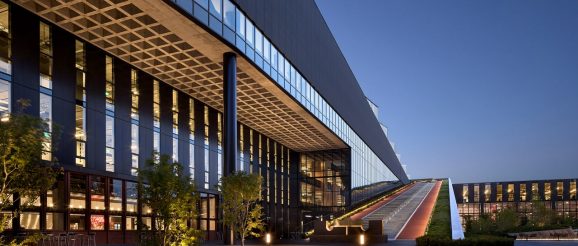Exclusive Tour of the Stunning New LeBron James Innovation Center on Nike’s Campus | Architectural Digest

Just as how LeBron James constantly pays homage to his upbringing in Akron, Ohio, Nike’s newest building has a distinct nod to its origin story too. The front of the building boasts a bold, cantilevering extension that greets each visitor. The space that juts out is where much of the 84,000 square-foot Nike Sport Research Lab is housed, featuring a full-size basketball court, a 200-meter track, and artificial turf field. But what really separates this space from any other sports research lab is the world’s largest motion-capture installation (over 400 cameras) and 97 force plates. These force plates are so sensitive, they can record someone’s heartbeat by simply standing on it.
The cantilevered extension is where Nike’s Sport Research Lab is now housed.
But in order to use such technical instruments, the Sport Research Lab needed to be located on the ground floor, a move that would’ve gone against the wishes to have the lab located on the top floor. So, AD100 architect Tom Kundig decided to get innovative. “When we asked a structural engineer what material would work to facilitate such sensitive floorboards above it, they gave us one answer: The waffle-iron pattern,” Kundig says. “It was so unthinkably serendipitous.”
Visitors are first greeted by some of LeBron James’s most iconic footwear, which is enclosed in a small, intimate space meant to symbolize the feel of a shoebox.
The serendipity Kundig is referring to goes back to Nike’s very beginning. “Nike’s co-founder Bill Bowerman was famous for ruining his wife’s waffle iron,” says Tinker Hatfield, a legendary sneaker designer and current vice president for design and special projects at Nike. What Hatfield is referencing is how, in the early 1970’s, Bowerman was trying to create a waffle-iron rubber sole for new footwear that would grip but be lightweight at the same time. And voilà, the iconic waffle-iron sole was born. “But you know, Bowerman’s wife never told him to stop breaking the waffle irons because she knew that’s the process of being innovative,” Hatfield continues. “It’s about experimenting, about being a failure and making mistakes and then coming up with something that’s actually quite wonderful.”
LeBron James shooting a basketball amongst hundreds of tiny dots that Nike data scientists placed on the floor. The open circles represent James’s missed shots while the filled circles are his made shots on the way to set his record of 30,000 NBA points.
But the building was not just built for pushing boundaries inside its walls. It was designed to do so on the outside too. Directly outside of the front entrance, the architect has designed a 15.63% incline ramp that extends more than 500 feet. This space is not for sheer aesthetics (although it does look quite nice), but rather offers athletes the opportunity for training on a campus that is void of any natural hills. With this deft stroke in design, architecture firm Olson Kundig has turned the façade into something beautifully utilitarian.
Much of the office space has an open, highly collaborative feel to it. The majority of the connecting points between floors, such as the stairs, are made of steel. “I think [steel] is such a beautiful material,” Tom Kundig explains. “Depending on whether you fold, weld, or shape it, you can take something unwieldy and turn it into art.”
The building was designed to house 700 Nike staffers such as developers in materials and apparel innovation. The interior space of the innovation center is highly polished, yet has an unfinished feel to it. Much can be said about the fine tuning of an elite athlete—the quality is there, but the room for growth is never-ending. Yet, perhaps the most important part of the building for LeBron is the restaurant “Glo’s,” named in honor of his mother, Gloria Marie James. Inside the restaurant is a mural showcasing highlights from LeBron’s career, including original basketball trophies from his early years embedded into the wall.
LeBron James looking at the wall mural inside Glo’s, a restaurant in the building named after his mother.
Ultimately, what Nike hopes to accomplish with their stunning new innovation building is unlocking more ways to push athletes performances to higher levels. They plan to do this by way of data science and the most innovative apparel on the market. And in the 36-year-old James (a man who is still dunking over stars almost half his age) there is perhaps no better athlete for the brand to align with in this pursuit of long-lasting athletic perfection. “Having my name on the Nike’s innovation building feels fitting,” James says, “because I’m always trying to figure out ways in which I can continue to innovate and break the timeline of what they say is your prime.” Perhaps we should add motivational speaker to the rolling list of LeBron’s abilities.
